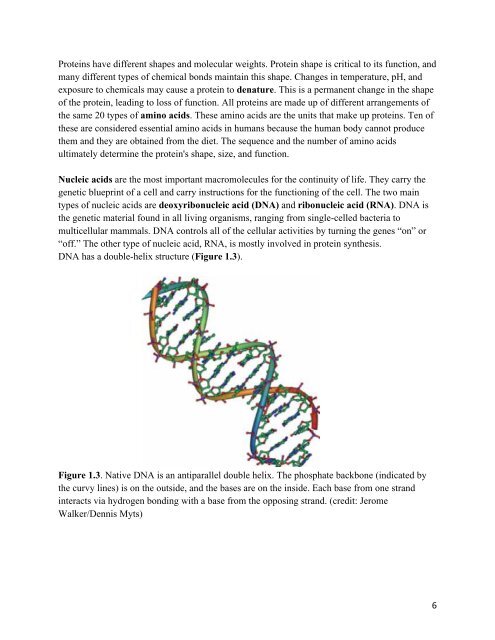Introduction to Environmental Science, 2nd Edition, 2018a
Introduction to Environmental Science, 2nd Edition, 2018a
Introduction to Environmental Science, 2nd Edition, 2018a
You also want an ePaper? Increase the reach of your titles
YUMPU automatically turns print PDFs into web optimized ePapers that Google loves.
Proteins have different shapes and molecular weights. Protein shape is critical <strong>to</strong> its function, and<br />
many different types of chemical bonds maintain this shape. Changes in temperature, pH, and<br />
exposure <strong>to</strong> chemicals may cause a protein <strong>to</strong> denature. This is a permanent change in the shape<br />
of the protein, leading <strong>to</strong> loss of function. All proteins are made up of different arrangements of<br />
the same 20 types of amino acids. These amino acids are the units that make up proteins. Ten of<br />
these are considered essential amino acids in humans because the human body cannot produce<br />
them and they are obtained from the diet. The sequence and the number of amino acids<br />
ultimately determine the protein's shape, size, and function.<br />
Nucleic acids are the most important macromolecules for the continuity of life. They carry the<br />
genetic blueprint of a cell and carry instructions for the functioning of the cell. The two main<br />
types of nucleic acids are deoxyribonucleic acid (DNA) and ribonucleic acid (RNA). DNA is<br />
the genetic material found in all living organisms, ranging from single-celled bacteria <strong>to</strong><br />
multicellular mammals. DNA controls all of the cellular activities by turning the genes “on” or<br />
“off.” The other type of nucleic acid, RNA, is mostly involved in protein synthesis.<br />
DNA has a double-helix structure (Figure 1.3).<br />
Figure 1.3. Native DNA is an antiparallel double helix. The phosphate backbone (indicated by<br />
the curvy lines) is on the outside, and the bases are on the inside. Each base from one strand<br />
interacts via hydrogen bonding with a base from the opposing strand. (credit: Jerome<br />
Walker/Dennis Myts)


















